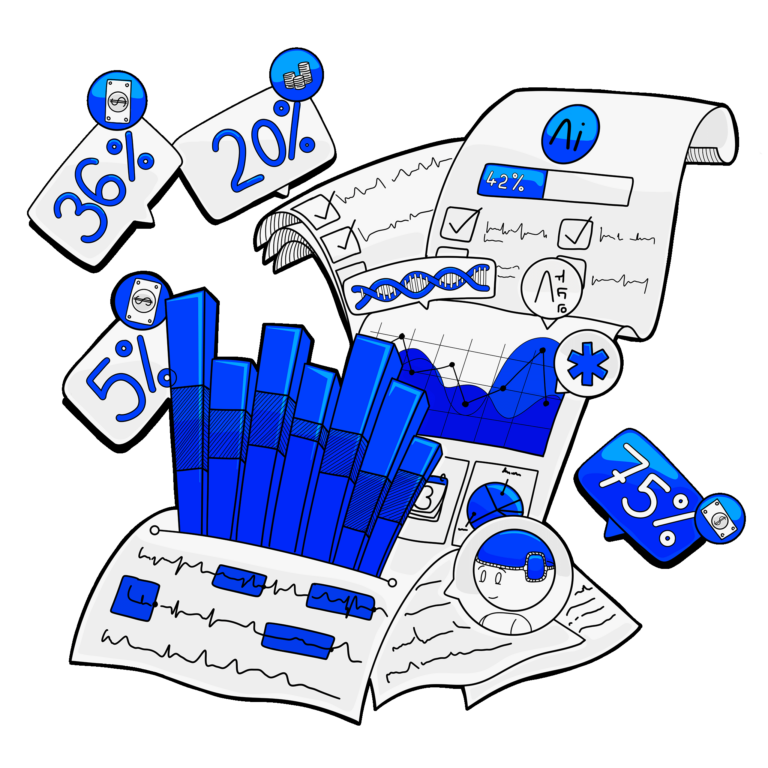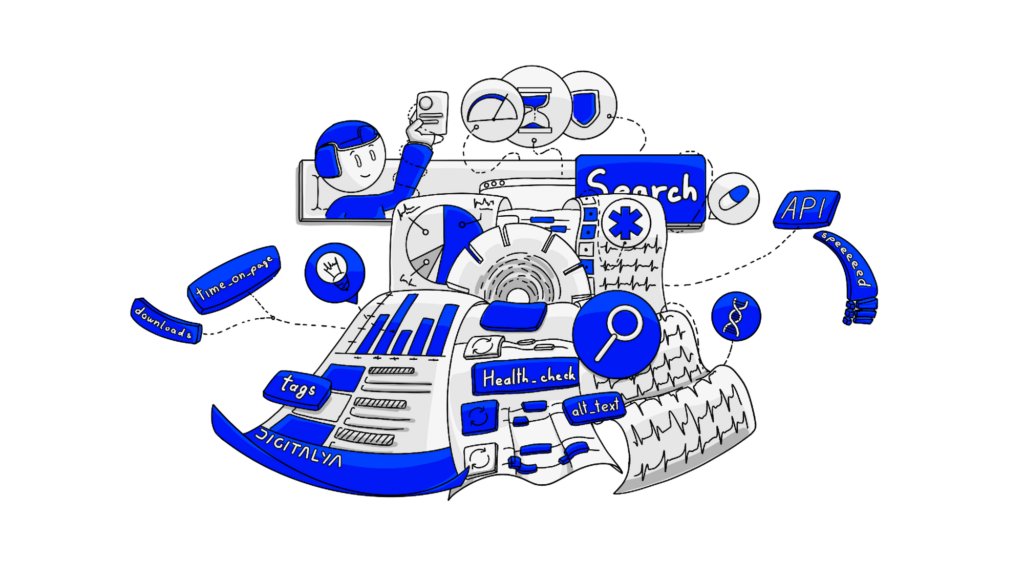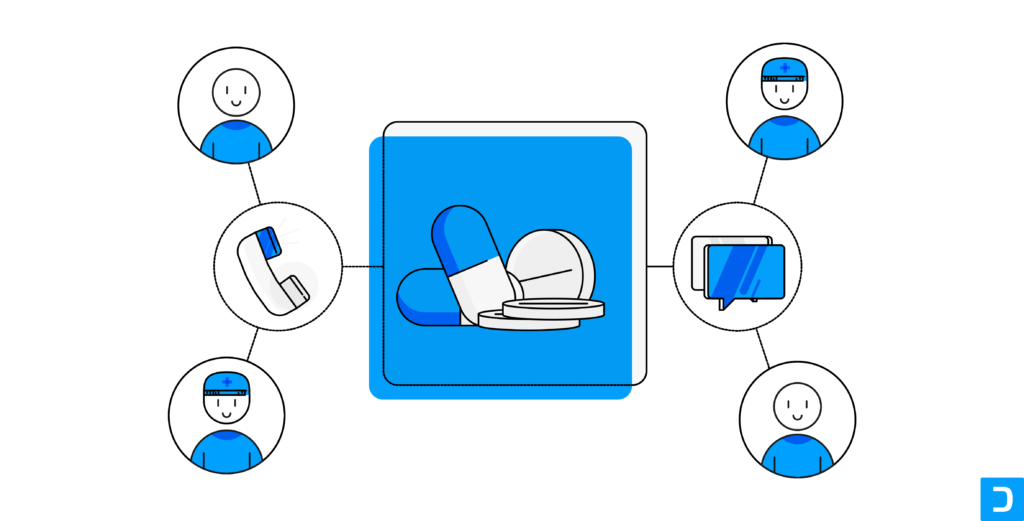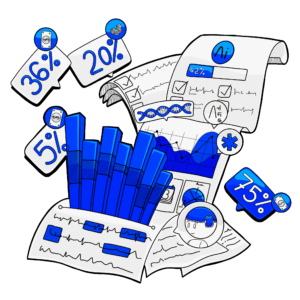With the arrival of today’s digital age, this bridge has extended into the virtual realm, creating a need for a more comprehensive and unified perspective in pharma marketing strategies. The pharmaceutical sector is undergoing significant transformation due to regulatory changes and technological advancements.
New technologies are enabling more integrated and strategic approaches in pharma marketing.
The possibilities seem limitless in this evolving world of pharma, depending on the imagination of pharmaceutical marketers.
To help out, we’ll explore three strategies that can help pharmaceutical companies navigate this dynamic landscape effectively.
The importance of a unified perspective in pharma marketing
The practice of utilizing digital channels and technologies to promote pharmaceutical products and engage with healthcare providers and patients is a norm now.
Digital platforms, online platforms, and mobile apps have become key components of digital pharma marketing, enabling personalized, real-time communication and engagement.
These tools help pharmaceutical companies reach specific target groups and target markets, such as healthcare providers and patients, through tailored messaging and value-based healthcare communications.
A unified marketing strategy, the pharma industry relies on the omnichannel strategy, going further with customized messages based on touchpoints and consumer behavior.
Even though not all companies have reached this level, research from Graphite Digital shows that 50% of pharma marketers report advanced maturity. Qualitative feedback points to fragmented systems and stalled strategies, but it’s clear that the direction is towards increasing efforts to achieving omnichannel maturity.
Omnichannel encompasses a wide array of sales and marketing activities, from online advertising and social media engagement to email marketing, conference coverage, and HCP portals. Marketing teams use these digital platforms as essential marketing tools to coordinate efforts and engage audiences more effectively.
Why achieving a unified view is essential for your pharma marketing strategy?
The pharmaceutical industry is uniquely complex. It bears stringent regulations, diverse customer segments, and, most of all, rapidly evolving medical knowledge. In this challenging context, achieving a unified view in pharma marketing is not just beneficial; it’s imperative. Here’s why:
- Enhanced Customer Engagement
A unified view allows pharmaceutical companies to understand their audience’s preferences, behaviors and needs comprehensively. Achieving this requires a deep understanding of the product, target audience, and market landscape to tailor communications effectively. This knowledge empowers them to tailor their communications, resulting in better informed and more loyal key opinion leaders, followed by more engaged and satisfied customers, just like when they employ omnichannel strategies, but at an even higher level.
- Data-Driven Decision-Making
In an industry where precision is key, data is gold. A unified view in digital marketing, especially in the world of pharma, provides access to integrated, accurate data analytics, enabling informed decision-making and precise targeting. Pharma marketing data, used wisely, helps companies deliver content that targeted audiences are genuinely interested in and identify and communicate what is relevant for both doctors and patients.
- Cost Optimization
Omnichannel technologies that ensure the delivery of consistent messages across channels translate into effective marketing. This way, a pharma company can plan its content marketing and optimize its marketing spend. Achieving more cost efficiency is crucial for pharma companies to remain competitive in a highly regulated and evolving healthcare environment.
Now, let’s take a closer look at three strategies for achieving a unified view in pharma marketing.
Strategy 1: Integrated Data Management
For pharma companies to reach their target audience and key opinion leaders with customized messages that deliver valuable information, they need to know the most they can about their customers – their interests, digital behavior, user journey, learning patterns, role and value, and so on. By leveraging data, pharma companies can gain deeper consumer insights and map the entire customer journey, allowing for more personalized and effective engagement.
Such various information may seem difficult to harness, not to mention integrate into the marketing efforts. Yet, a clever data management strategy that enables personalization and segmentation will empower pharma companies to put into practice effective marketing strategies, reach wider audiences, enable effective resource allocation, and increase the return on investment.
Centralized Data Repository for Comprehensive Insights
Building a centralized data repository that gathers and stores all relevant data is the first step. From sales figures to customer interactions, this repository provides a comprehensive view of the value chain, customer behavior, preferences, and engagement across different touchpoints.
For this, due to the many particularities of the industry, it is important for pharmaceutical marketers to consider custom software development, which will allow them to gather and integrate data from various sources.
Data Integration for Holistic Understanding in the Pharma Industry
Integration of data from various sources, such as CRM systems, custom marketing automation software, social media, search engines, and more, offers a holistic understanding of customer interactions and helps identify trends and patterns.
The better you know the profiles of the health care providers with whom you interact, even of their patients, the more valuable the delivered content and the interactions. In the healthcare industry, especially, professionals are very attentive with their time and energy.
They don’t want these resources wasted, so they’ll value those pharmaceutical brands that show respect and provide valuable content.
Ensuring Data Quality for Accurate Analysis
Valuable and actionable insights are possible only if you ensure data accuracy, consistency, and cleanliness. These are paramount. Implement data validation processes and regular data cleansing to prevent inaccuracies that can hinder your unified view efforts.
It will help your sales force not to waste time and your marketing team to successfully market the products to the right people, on the right channels, at the right moment.
Strategy 2: Advanced Analytics and Insights
Data management is one strategy that provides valuable information to work with, to design effective pharma marketing strategies and tactics. Leveraging advanced technologies such as artificial intelligence and machine learning is transforming pharma marketing by enabling deeper analytics, improved personalization, and enhanced data-driven decision-making.
Still, you can go a step further to understand the market more in-depth and to foresee what’s coming. Understanding market dynamics is essential for developing key strategies that respond to changing conditions and prescribing behaviors, ultimately driving commercial success.
Harnessing Predictive Analytics for Informed Decision-Making
Predictive modeling can forecast customer behavior, drug demand, and market trends, enabling you to tailor marketing strategies accordingly. It’s always good to be prepared for what’s coming, especially in the evolving world of pharma.
Anticipating trends is no longer the privilege of a few visionaries. With the right tools, you can have your own „crystal globe” in the form of machine learning and artificial intelligence-powered software that is able to „see in the future” based on current data.
A healthcare development company can help you build a customized tool, your own „globe,” to support you in effective drug advertising to reach a wider audience, for instance, or to perform better in search engines.
Effective Segmentation for Personalized Pharma Marketing
We talked about the importance of personalization in pharma marketing when we touched on the subject of omnichannel in healthcare. The better the message is adapted to the specific needs and expectations of the healthcare professionals, the more chances to reach their target and get a positive reaction.
In a study by Across Health conducted in the US in 2022, it was revealed that one of the factors that determine an optimal user experience is knowing the professional interests of the HCP. But how can a pharmaceutical representative know such details?
The secret lies in effective segmentation that allows you to identify precisely the type of information each segment of your audience needs to receive.
Divide your audience into meaningful segments based on factors like demographics, behavior, preferences, and needs. This allows for crafting personalized marketing strategies and personalized messaging for each segment. It is also important to develop effective marketing messages tailored to the unique characteristics and needs of each segment.
Real-time Analytics for Dynamic Campaign Optimization
Once you put your efforts into marketing planning and designing pharmaceutical advertising campaigns, you want to make sure they pay off. Real-time analytics can help optimize marketing campaigns by providing actionable insights that improve engagement and effectiveness. As you very well know, the pharma landscape is very dynamic, and you can expect shifts and turns right around the corner.
Things may change from the moment you approve the plan or a campaign. Stay agile and rely, in your strategy, on real-time data to optimize the campaigns as the market shifts.
Utilize analytics tools to monitor real-time campaign performance and customer engagement; they empower you to make data-driven adjustments on the fly and optimize your marketing efforts as they unfold. Having the capability for these advanced analytics and segmentation within your system can significantly streamline your efforts. It is also crucial to monitor each marketing campaign closely to ensure its effectiveness and adapt strategies as needed.
Strategy 3: Cross-Channel Coordination
A third pharmaceutical good marketing strategy focuses on coordinating multiple pharma marketing channels for a coherent experience and message delivery. Relationship building with healthcare professionals, including KOLs and doctors, is crucial in this process and should be fostered through both digital engagement and traditional face to face interactions.
This approach maximizes the chances of reaching target audiences on multiple touchpoints, with an increased positive impact on brand loyalty and adoption. You may even include building an HCP portal that will automate the delivery of customized experiences for your specific audiences.
Omnichannel Approach for Cohesive Customer Journeys
One good way to offer your customers valuable experiences is to use a healthcare omnichannel platform that will automate the process and ensure each audience segment gets the dedicated information when and where they are more open to it.
Ensure consistency and coherence across all pharma marketing channels – digital, traditional, and in-person. A seamless experience enhances brand perception and fosters a more unified customer experience. The study by Across Health mentioned before also showed a growing preference for e-engagements across channels among HCPs, compared to the pre-COVID period in 2019.
This means that the more channels you include in your pharma marketing activities, the more chances you have to convert potential customers. The key is to deliver consistency and coherence across these channels, both online and in person.
Crafting a Unified Content Strategy Across Pharma Marketing Channels
Once you have identified the respective channels for each customer segment, designing the content marketing strategy is the following step. Stay true to your message by making sure you keep the same key ideas no matter where you display them: by e-mail, on social media, Google ads, webinars, brochures, or in-person presentations.
Develop a unified content strategy that aligns with your messaging and objectives. It is important to make sure that your marketing materials convey a consistent brand image and message across all channels. It is all about repetition.
With so many messages to which people are exposed daily and a diminishing attention span, repetition is what helps information stick. However, be aware of redundancy. Consider variations in form. You can write different texts and design different materials to use on e-mail, social media, blog posts, and ads.
In an e-mail, you can write more and use fewer images, while for social media, you need to focus on short, clear, to-the-point headlines with powerful visuals. All these, however, should follow the same red thread and deliver the same key message that is consistent with the target customers’ needs in the brand’s tone of voice.
Leveraging Pharma Marketing Automation for Seamless Execution
All these steps may seem overwhelming. So many details to consider and so much effort to employ. Not necessarily. Technology is a reliable assistant and can simplify most of these healthcare marketing operations.
Also, you don’t have to do it by yourself. Reach out to a pharma web development company that can build you a custom platform or software that will automate the implementation of the omnichannel marketing strategy.
The agency model in pharma is evolving, with agencies now integrating digital and data-driven services specifically designed to support life sciences companies. Consider building a custom marketing automation solution that can integrate with your existing tools and is tailored to the particularities of pharma and the regulatory environment.
So don’t hesitate to implement marketing automation tools to orchestrate campaigns and communications across various channels, especially when artificial intelligence technology is at hand. This streamlines your efforts and ensures that customers receive timely and relevant messages, enhancing the unified experience.
Considerations for Regulatory Compliance and Privacy
If things didn’t look complicated already, let’s talk about compliance regulations and privacy in a cookieless future. All sectors have their respective demands and codes of conduct, but the healthcare realm is one of the most attentively regulated domains. The complex regulatory landscape in the pharmaceutical industry requires companies to navigate stringent rules and oversight, making it essential to adhere to legal and ethical standards at every step.
And reasonably so, considering the personal information you operate with. Therefore, for any marketing actions you employ for healthcare providers, be sure you obey the local and national regulatory systems in place.
In the pharmaceutical industry, strict regulations such as GDPR and HIPAA govern the collection and use of customer data. Ensure that your unified view strategy adheres to these regulations to protect customer privacy, especially when you consider building an HCP portal or other custom omnichannel software.
Doctors’ and patients’ data, while vital for designing useful content that can improve, in the end, patient outcomes also need strict protection and careful use.
Consider checking three main aspects:
- Ensure Data Privacy
Right from the beginning, when you start building custom software or subscribe to existing digital tools, make sure there are solid protocols and systems in place to protect user and patient data, both private and public. Check the requirements for adhering to regulations and industry best practices and make sure that your company, as well as your partners, are compliant. Pharmaceutical sales representatives play a key role in ensuring compliance with regulations during their interactions with healthcare professionals, helping to maintain trust and transparency.
- Do Proper Consent Management
Although it may seem a tedious activity (both for your team and the healthcare providers approached by your sales force), we assure you it is important, and you’ll thank yourself later for not skipping this step. We cannot emphasize enough how important is to obtain explicit consent from customers for data usage and communication.
- Be Transparent
Last but not least, communicate your data usage practices and privacy policies to customers. Show that you have nothing to hide, no hidden interest or agenda. This way, you’ll gain their trust and loyalty.
Unifying Pharma Marketing Strategies for Success
Pharmaceutical firms are focusing on improving patient outcomes and meeting HCP needs through direct to consumer strategies. The crucial role of pharmaceutical marketing lies in attracting customers and driving success in the industry. It’s not just about selling pharmaceutical products; it’s about improving lives and healthcare outcomes through informed and unified marketing strategies.
Achieving a unified view in pharma marketing is no longer optional; it’s a competitive necessity in the world of pharma. The top three strategies outlined here – integrated data management, advanced analytics and insights, and cross-channel coordination – form the foundation for success in this dynamic and regulated landscape.
By embracing these strategies and considering the regulatory and privacy aspects, pharmaceutical companies can position themselves for marketing success in the digital age.







